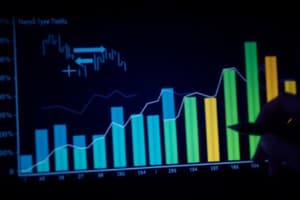Podcast
Questions and Answers
How do endocrine glands differ from other types of glands in the body?
How do endocrine glands differ from other types of glands in the body?
- They produce hormones that regulate only reproductive functions.
- They primarily regulate body temperature through thermoregulation.
- They secrete chemicals into ducts that lead to target organs.
- They secrete chemicals directly into the bloodstream to be carried to distant target organs. (correct)
Which of the following mechanisms is activated by the hypothalamus when body temperature falls?
Which of the following mechanisms is activated by the hypothalamus when body temperature falls?
- Inhibition of hormone production by the pituitary gland.
- Secretion of insulin to decrease glucose production.
- Activation of heat-promoting mechanisms. (correct)
- Activation of heat-loss mechanisms.
What is the primary role of insulin, a hormone produced by the islets of Langerhans in the pancreas?
What is the primary role of insulin, a hormone produced by the islets of Langerhans in the pancreas?
- To stimulate the fight-or-flight response.
- To regulate the production of thyroid hormones.
- To increase blood glucose levels.
- To decrease blood glucose levels. (correct)
Which of the following statements best describes 'negative feedback' as a homeostatic mechanism?
Which of the following statements best describes 'negative feedback' as a homeostatic mechanism?
How can synthetic estrogen and progesterone be used commercially?
How can synthetic estrogen and progesterone be used commercially?
In the context of type 2 diabetes, how do cells of the body respond to insulin?
In the context of type 2 diabetes, how do cells of the body respond to insulin?
Which gland is located near the pituitary gland in the brain and regulates hormone production by the pituitary gland?
Which gland is located near the pituitary gland in the brain and regulates hormone production by the pituitary gland?
What is the primary function of the hormones triiodothyronine (T3) and thyroxine (T4) secreted by the thyroid gland?
What is the primary function of the hormones triiodothyronine (T3) and thyroxine (T4) secreted by the thyroid gland?
Which of the following best describes homeostasis?
Which of the following best describes homeostasis?
What is the role of adrenaline, a hormone produced by the adrenal glands?
What is the role of adrenaline, a hormone produced by the adrenal glands?
What is the main difference in how the endocrine and nervous systems transmit messages?
What is the main difference in how the endocrine and nervous systems transmit messages?
Which of these is an example of a bodily process regulated by a negative feedback mechanism?
Which of these is an example of a bodily process regulated by a negative feedback mechanism?
What commercial application involves the use of hormones to treat muscular disorders?
What commercial application involves the use of hormones to treat muscular disorders?
How is hormone replacement therapy used to treat diseases?
How is hormone replacement therapy used to treat diseases?
Which hormones are secreted by the ovaries to regulate the activity of the female reproductive organs?
Which hormones are secreted by the ovaries to regulate the activity of the female reproductive organs?
What is the endocrine function of the testes?
What is the endocrine function of the testes?
What is the role of glucagon injections in managing diabetes?
What is the role of glucagon injections in managing diabetes?
In agriculture, how are hormones commercially utilized?
In agriculture, how are hormones commercially utilized?
Which of the following is a treatment for hypothyroidism?
Which of the following is a treatment for hypothyroidism?
Where are the endocrine cells of the pancreas located?
Where are the endocrine cells of the pancreas located?
Flashcards
Hormones
Hormones
Chemical messengers produced by endocrine glands, transported in the blood to target specific body parts.
Endocrine Glands
Endocrine Glands
Glands that secrete hormones directly into the bloodstream to affect responses in specific body parts.
Major Endocrine Glands
Major Endocrine Glands
The thyroid, pituitary, and adrenal glands.
Exocrine Glands
Exocrine Glands
Signup and view all the flashcards
Endocrine Pancreas
Endocrine Pancreas
Signup and view all the flashcards
Insulin vs. Glucagon
Insulin vs. Glucagon
Signup and view all the flashcards
Diabetes Mellitus
Diabetes Mellitus
Signup and view all the flashcards
Adrenaline
Adrenaline
Signup and view all the flashcards
Ovarian Hormones
Ovarian Hormones
Signup and view all the flashcards
Testosterone
Testosterone
Signup and view all the flashcards
Thyroid Hormones
Thyroid Hormones
Signup and view all the flashcards
Pituitary Gland
Pituitary Gland
Signup and view all the flashcards
Hypothalamus Function
Hypothalamus Function
Signup and view all the flashcards
Homeostasis
Homeostasis
Signup and view all the flashcards
Thermoregulation
Thermoregulation
Signup and view all the flashcards
Negative Feedback
Negative Feedback
Signup and view all the flashcards
Constant Internal Temperature
Constant Internal Temperature
Signup and view all the flashcards
Negative Feedback
Negative Feedback
Signup and view all the flashcards
Hormone Treatments
Hormone Treatments
Signup and view all the flashcards
Estrogen and Progesterone
Estrogen and Progesterone
Signup and view all the flashcards
Study Notes
- Algorithmic trading, quantitative trading, and high-frequency trading are discussed.
- Market microstructure is introduced.
- A roadmap of the book is presented.
Market Data
- Market data feeds are explored.
- The order book shows the list of buy and sell orders for a security.
- Top of the book refers to the best bid and offer prices available.
- Last trade indicates the price at which the most recent transaction occurred.
- Historical data is past market information that can be used for analysis.
- Exchange APIs (Application Programming Interfaces) provide real-time market data and order execution capabilities.
- Data vendors supply market data to traders and investors.
- ITCH and OUCH are protocols that facilitate high-speed data transmission.
- FIX (Financial Information Exchange) protocol is a standard for electronic communication in trading.
- Data normalization involves cleaning and organizing market data for consistency.
- Data storage is the process of saving market data for future use.
- Order book simulation is discussed.
- Data-driven simulation uses historical data to simulate market conditions.
- Agent-based modeling simulates the behavior of individual traders and their impact on the market.
Order Placement
- Order types are explained:
- Market order: An order to buy or sell a security immediately at the best available price.
- Limit order: An order to buy or sell a security at a specific price or better.
- Stop order: An order that becomes a market order when a specified price is reached.
- Good-til-cancel (GTC) order: An order that remains active until it is filled or canceled.
- Immediate-or-cancel (IOC) order: An order that must be filled immediately, and any unfilled portion is canceled.
- Fill-or-kill (FOK) order: An order that must be filled completely and immediately, or it is canceled.
- All-or-none (AON) order: An order that must be filled completely, but not necessarily immediately.
- Market-on-close (MOC) order: An order to be executed as close as possible to the end of the trading day.
- Trailing stop order: A stop order with a stop price that adjusts as the market price fluctuates.
- Hidden order: An order that is not displayed in the order book.
- Pegged order: An order with a price that is linked to the best bid or offer.
- Order attributes are described.
- Order routing is explored:
- Smart order router (SOR): An automated system that seeks the best available price and execution venue for an order.
- Order management system (OMS) is a system used to manage and track orders.
Market Impact
- Market impact is defined.
- The market impact of a single order is examined:
- Temporary impact: The short-term price movement caused by an order.
- Permanent impact: The lasting effect of an order on the market price.
- Impact function: A mathematical representation of the relationship between order size and market impact.
- An example of market impact estimation is provided.
- The market impact of an order flow is discussed:
- Kyle model: A model that describes the relationship between order flow and price movement.
- Glosten-Milgrom model: A model that explains how information is incorporated into prices through trading.
- Optimal execution is explored:
- Slippage: The difference between the expected price of a trade and the actual price at which it is executed.
- Execution shortfall: The difference between the actual cost of executing a trade and the expected cost based on pre-trade estimates.
- VWAP (Volume-Weighted Average Price) and TWAP (Time-Weighted Average Price) are execution benchmarks.
- Implementation shortfall: A measure of the difference between the performance of a trading strategy and the performance achieved by a benchmark.
Transaction Cost Analysis
- Cost components are identified:
- Explicit costs: Direct costs associated with trading, such as commissions and exchange fees.
- Implicit costs: Indirect costs associated with trading, such as market impact and opportunity cost.
- Cost estimation is discussed:
- Pre-trade analysis: Estimating transaction costs before executing a trade.
- Post-trade analysis: Evaluating actual transaction costs after a trade has been executed.
Execution Tactics
- Market-making is examined:
- Inventory management: The process of managing a market maker's inventory of securities.
- Order placement: The specific strategies used by market makers to place orders.
- Risk management: Techniques used by market makers to manage the risks associated with their activities.
- Order splitting is discussed:
- Volume-Weighted Average Price (VWAP): An order splitting strategy that aims to execute a trade at the VWAP.
- Time-Weighted Average Price (TWAP): An order splitting strategy that aims to execute a trade at the TWAP.
- Percentage of volume (POV): An order splitting strategy that executes a fixed percentage of the market volume.
- Adaptive shortfall: An order splitting strategy that adapts to changing market conditions to minimize execution shortfall.
- Smart order routing is explored:
- Routing logic: The criteria used by a smart order router to select the best execution venue.
- Venue analysis: The process of evaluating different execution venues.
Pairs Trading
- Mean reversion is described.
- Distance methods are explained:
- Euclidean distance: A measure of the distance between two data points.
- Correlation: A statistical measure of the relationship between two variables.
- Cointegration: A statistical property of two or more time series that indicates they have a long-run equilibrium relationship.
- Statistical arbitrage is discussed.
Trading Strategies
- Trend following is examined:
- Moving average: A technical indicator that smoothes out price data by calculating the average price over a specified period.
- Moving average crossover: A trading signal that occurs when two moving averages with different periods cross each other.
- Turtle trading: A trend-following strategy developed by Richard Dennis and William Eckhardt.
- Sentiment analysis is explored:
- Data sources: Sources of sentiment data, such as news articles, social media, and financial reports.
- Sentiment indicators: Metrics used to measure market sentiment.
- Sentiment-based strategies: Trading strategies that use sentiment data to make decisions.
Risk Management
- Volatility is defined:
- Historical volatility: A measure of past price fluctuations.
- Implied volatility: A measure of the market's expectation of future price fluctuations, derived from option prices.
- Value at Risk (VaR) is discussed:
- Historical simulation: A method of calculating VaR based on historical data.
- Variance-covariance method: A method of calculating VaR based on the statistical properties of asset returns.
- Monte Carlo simulation: A method of calculating VaR based on simulating possible future scenarios.
- Capital allocation is explored.
Backtesting
- Data preparation is discussed.
- Performance metrics are explained:
- Profit and Loss (P&L): The difference between the revenue generated by a trading strategy and the costs incurred.
- Return on Investment (ROI): A measure of the profitability of a trading strategy relative to the amount of capital invested.
- Sharpe ratio: A measure of risk-adjusted return.
- Maximum drawdown: The largest peak-to-trough decline during a specified period.
- Implementation of backtesting is discussed.
- Pitfalls in backtesting are identified:
- Look-ahead bias: Using information that would not have been available at the time of the trading decision.
- Overfitting: Developing a trading strategy that performs well on historical data but poorly on new data.
- Transaction costs: Failing to account for the costs of trading when backtesting.
Studying That Suits You
Use AI to generate personalized quizzes and flashcards to suit your learning preferences.




